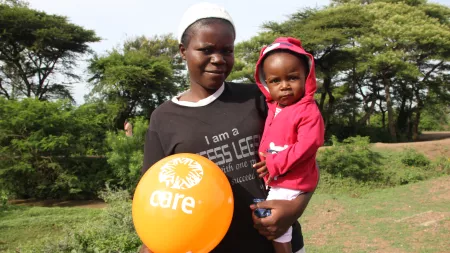Want to make a difference in nutrition? One step is getting men to understand nutrition isn’t just a woman’s problem. Roseline says, “Some of my friends wonder how I make it early to the market nowadays, they were all amazed and admired my marriage after narrating the story of my husband.”
It’s not always easy. “It was awkward when my husband started helping me with household chores even though I was impressed at first! So many questions crossed my mind because this was very unusual,” Roseline said.
Tom, Roseline’s husband, faced challenges, too. “It was hard to start doing these tasks and I was afraid of being labeled a coward African man, overpowered by my wife….I still don’t believe that I have changed this much.”
The Kenya Siaya Maternal and Child Nutrition Nawiri project ran from 2016-2019 in Siaya county, Kenya with $1.1 million in funding from the Austrian Development Cooperation. It reached 189,065 people directly (169,065 of whom were women), and 945,325 people indirectly. The CARE Kenya team partnered with Family Health Options Kenya, Kisumu Medical and Education Trust in Siaya County.
What changed?
- Kids got taller. Stunting (kids who are shorter because of malnutrition) dropped from 25.7% to 22%. That’s more than 8,300 kids who got a healthy start for the future.
- Health centers provide better services. By the end of the project, only 5% of health centers struggled to get the supplies they needed to treat malnutrition—down from 50% in 2016.
- Women get better health care. According to one health center manager, the number of women who came for prenatal visits at her health center nearly doubled. “Last year we were ranked number one in the sub-county and given a trophy as an evidence of what we do here”
- Women and kids are getting their vitamins. The percent of pregnant women taking iron and folic acid—critical for their health and the likelihood of surviving childbirth—went from 56% to 92% by the end of the project. There was also a 72% increase in exclusive breastfeeding for children—a critical component in child health and growth.
- Governments are investing in nutrition. The county budgets for nutrition services went up 5 TIMES to more than 5 million Kenyan Shillings ($34,247).
- Men think nutrition matters. There was an 83% drop in the belief that nutrition is just a woman’s problem. “......women are very happy, now the men are taking them to hospital. If the women go to clinic, men remain home and cook for the children lunch,” says on staff member. A community health worker says, “Boda boda youths (male motorcycle taxi riders) have been engaged and it has helped in understanding division of labor in terms of maternal health and men have been sensitized to know that everyone is equal in meal times.”
- Good nutrition seems possible. The percent of people who believed that nutrition is only for people who can afford it dropped 90%, down to 4% at the end of the project.
How did we get there?
- Educate men and women. Both men and women were 31% more likely to be able to name at least 3 healthy nutrition practices.
- Get better evidence for decisions. There was a 33% increase in health facilities that had quality data (up to 89%), and a 28% increase (up to 95%) that had data at the time they needed it. The Siaya County Research Committee also restarted to focus on providing good evidence. The team ran regular data quality audits and provided trainings for data staff at health centers.
- Get evidence in front of people who will use it. The project got evidence to 76 public officials to support decisions to increase budgets for nutrition. They also helped those officials create nutrition plans, allocate budget, and make sure the plans happened.
- Support health workers of all kinds. The project trained 36 health workers and 1,054 community health volunteers. Together, those people went out and trained 4,869 additional health workers. One health worker says, “The fact that a nutritionist comes to the facility a few days weekly has helped win the confidence of mothers to bring their children.”
- Look at social norms. The project worked with 10 Civil Society Organizations to do Social Analysis in Action, participatory theatre, and community mobilization to change the expectations around health care and promote health for everyone. The project also focused on male champions to support nutrition.
- Hold health centers accountable. The communities used the community scorecard to hold 21 health facilities accountable for providing quality services. Caroline manages a health center, and she says, “It was actually an eye opener for my team. Sometimes we think we are doing the best we can but then the process makes you realize that you can do more…”
- Adapt as you go. In the words of one staff member, “....we just realized that there is a team that we had not planned for very well, this is the team of teen mothers.” As a result, they focused more on reaching adolescents—work that is continuing in the newly-launched SHE SOARS project.
Want to learn more?
Check out the project evaluation and the project stories here.
